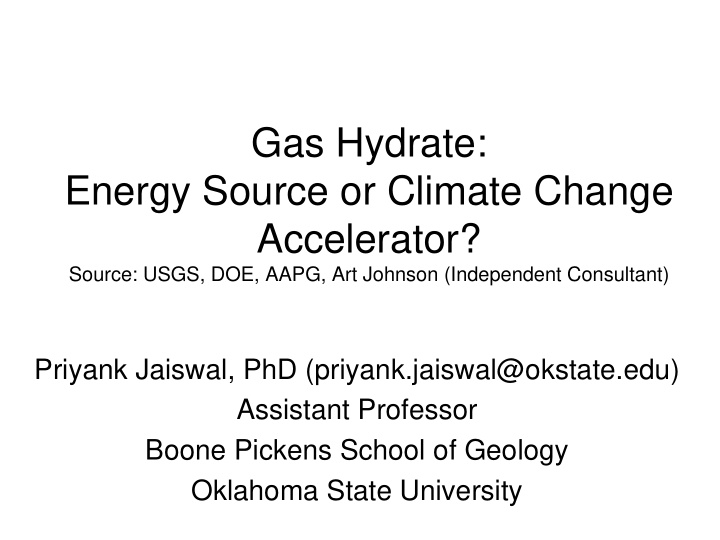



Gas Hydrate: Energy Source or Climate Change Accelerator? Source: USGS, DOE, AAPG, Art Johnson (Independent Consultant) Priyank Jaiswal, PhD (priyank.jaiswal@okstate.edu) Assistant Professor Boone Pickens School of Geology Oklahoma State University
Energy Use 1970
Energy Use 2005
Estimated Energy
Energy Resource
Predictive World Oil NGL: Natural gas liquids (liquids recovered from natural gas plants)
Gas Hydrate 1. A new resource? 2. How to find them? 3. How to quantify them? 4. Can we get them out? 5. Are they economic? 6. How will they impact the climate? 7. Where do we go in hydrate research?
1. International Hydrate Research
They are abundant!
They are plenty!
What are Gas Hydrate
Hydrate Structures
High Yield Resource
US Gas Reserves Base
Gas Hydrate 1. A new resource? 2. How to find them? 3. How to quantify them? 4. Can we get them out? 5. Are they economic? 6. How will they impact the climate? 7. Where do we go in hydrate research?
Hydrate Stability • Moderate Temperature and Pressure • Natural Occurance – Arctic permafrost – Shallow Marine • Source – Biogenic (predominantly biological agents) – Thermogenic (predominantly thermal regime)
Stability • Only a narrow zone where hydrates are stable • Unstable (?) and balance
Stability
Hydrate Physical Properties
Cores
Well Logging
Seismic Imaging
Resistivity
Gas Hydrate 1. A new resource? 2. How to find them? 3. How to quantify them? 4. Can we get them out? 5. Are they economic? 6. How will they impact the climate? 7. Where do we go in hydrate research?
Rock Model
Duality
Gas Hydrate 1. A new resource? 2. How to find them? 3. How to quantify them? 4. Can we get them out? 5. Are they economic? 6. How will they impact the climate? 7. Where do we go in hydrate research?
Probability Curve • There is a 95% chance we produce ~5% and only 5% chance we produce 40% of total reserves!
Messoyakha Field, Siberia
Production Technology • None of the above tested in marine • Depressurization tested in permafrost
Gas Hydrate 1. A new resource? 2. How to find them? 3. How to quantify them? 4. Can we get them out? 5. Are they economic? 6. How will they impact the climate? 7. Where do we go in hydrate research?
Concerns • High Risk (lack of understanding?) – Safety issues in drilling – Reservoir development – Temperature variations • Low Returns (lack of downstream) – No infrastructure in place – Long term research required – Limited and not assured prospect • Climate Change – Slope instability (Methane escape) – More fuel to burn??
Hydrate Cost-Benefit
Permafrost Case
Gas Hydrate 1. A new resource? 2. How to find them? 3. How to quantify them? 4. Can we get them out? 5. Are they economic? 6. How will they impact the climate? 7. Where do we go in hydrate research?
Negative Impact Was the PETM due to hydrate release? Thomas, D.J.; Zachos, J.C.; Bralower, T.J.; Thomas, E.; Bohaty, S. (2002). "Warming the fuel for the fire: Evidence for the thermal dissociation of methane hydrate during the Paleocene-Eocene thermal maximum". Geology 30 (12): 1067 – 1070
Hydrate Formers
Positive Impact • Can we replace CH 4 by CO 2 ?
Gas Hydrate 1. A new resource? 2. How to find them? 3. How to quantify them? 4. Can we get them out? 5. Are they economic? 6. How will they impact the climate? 7. Where do we go in hydrate research?
????? • ?????? • ????? • ??? • .. • .
Recommend
More recommend